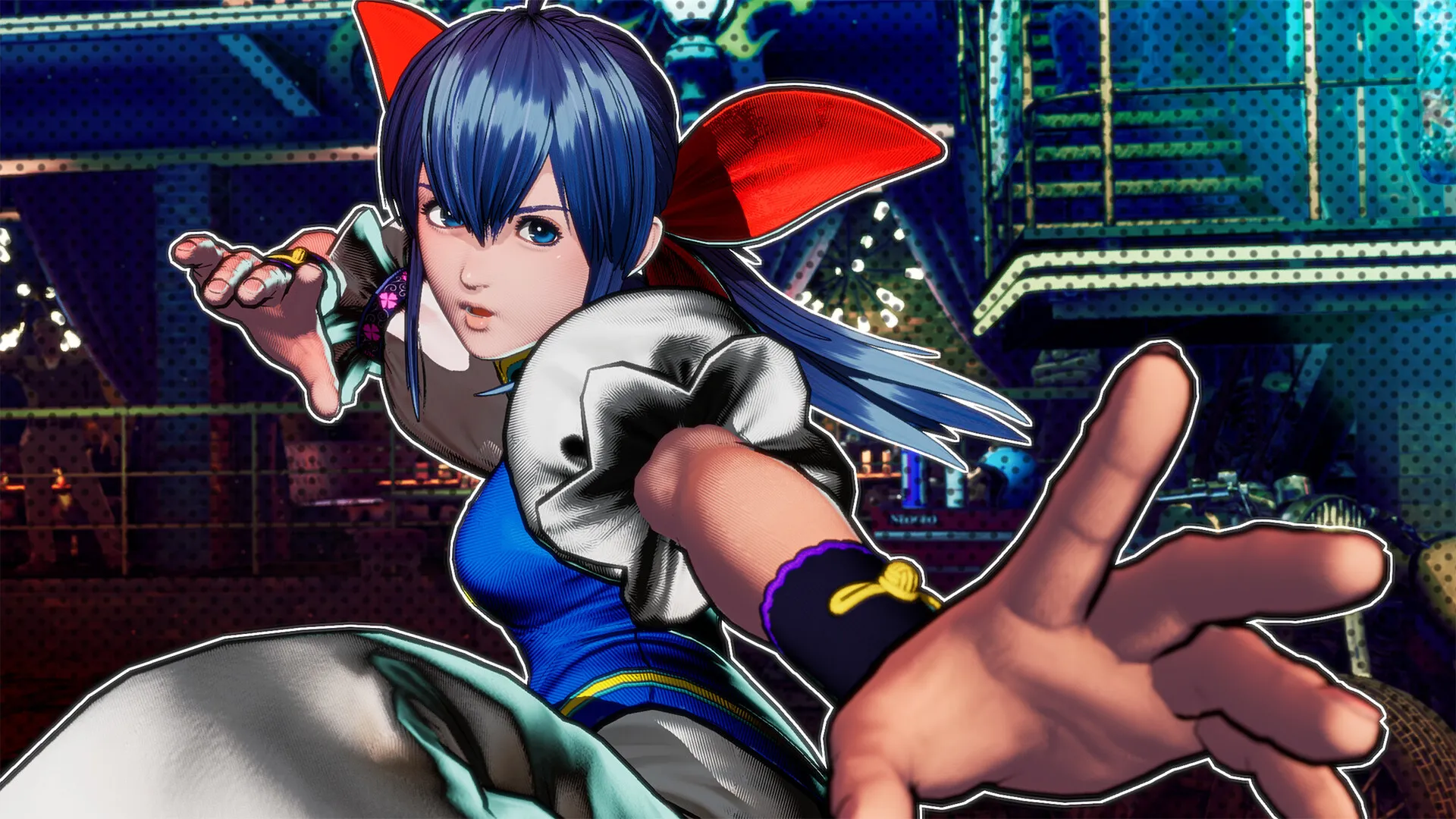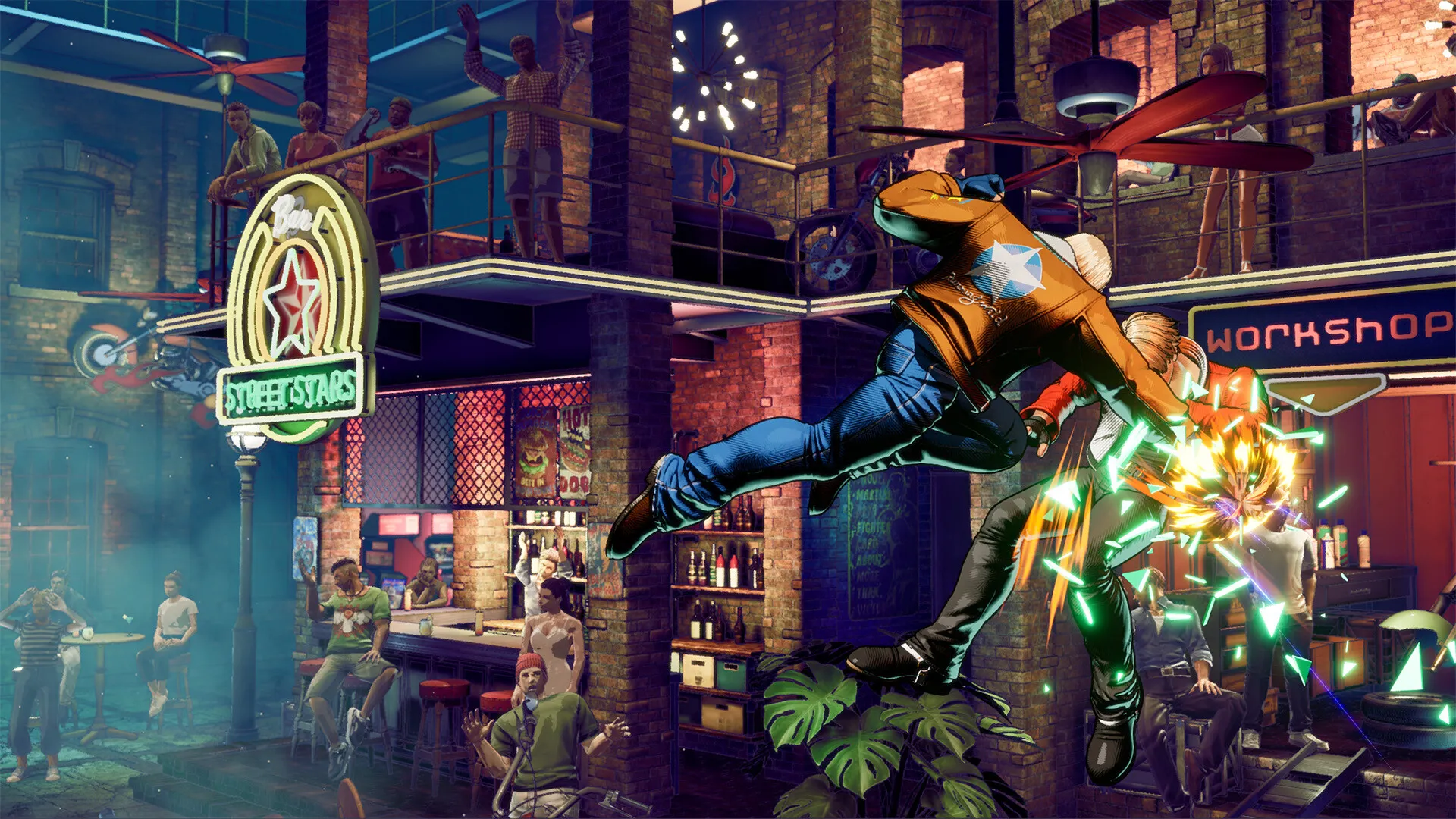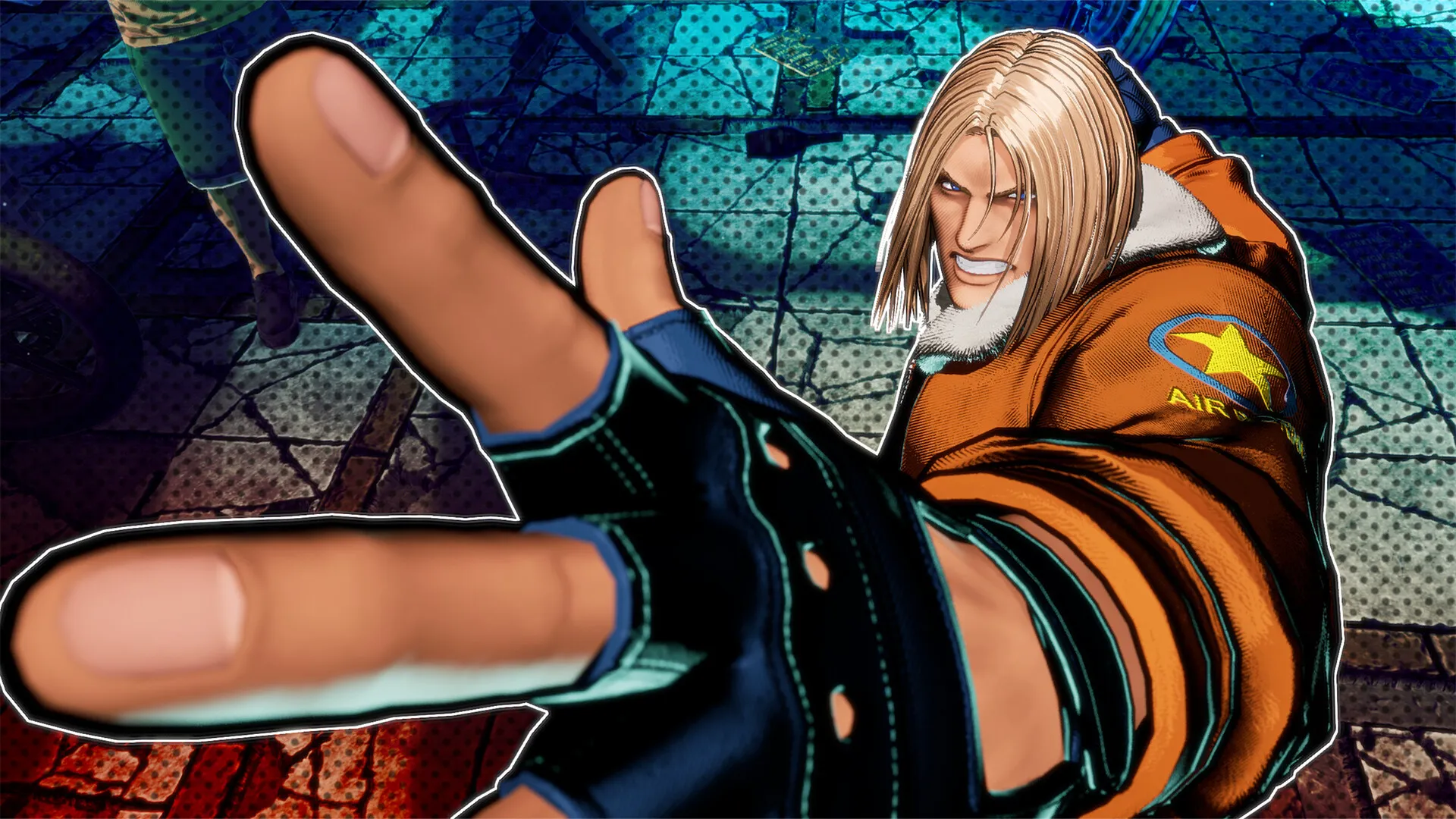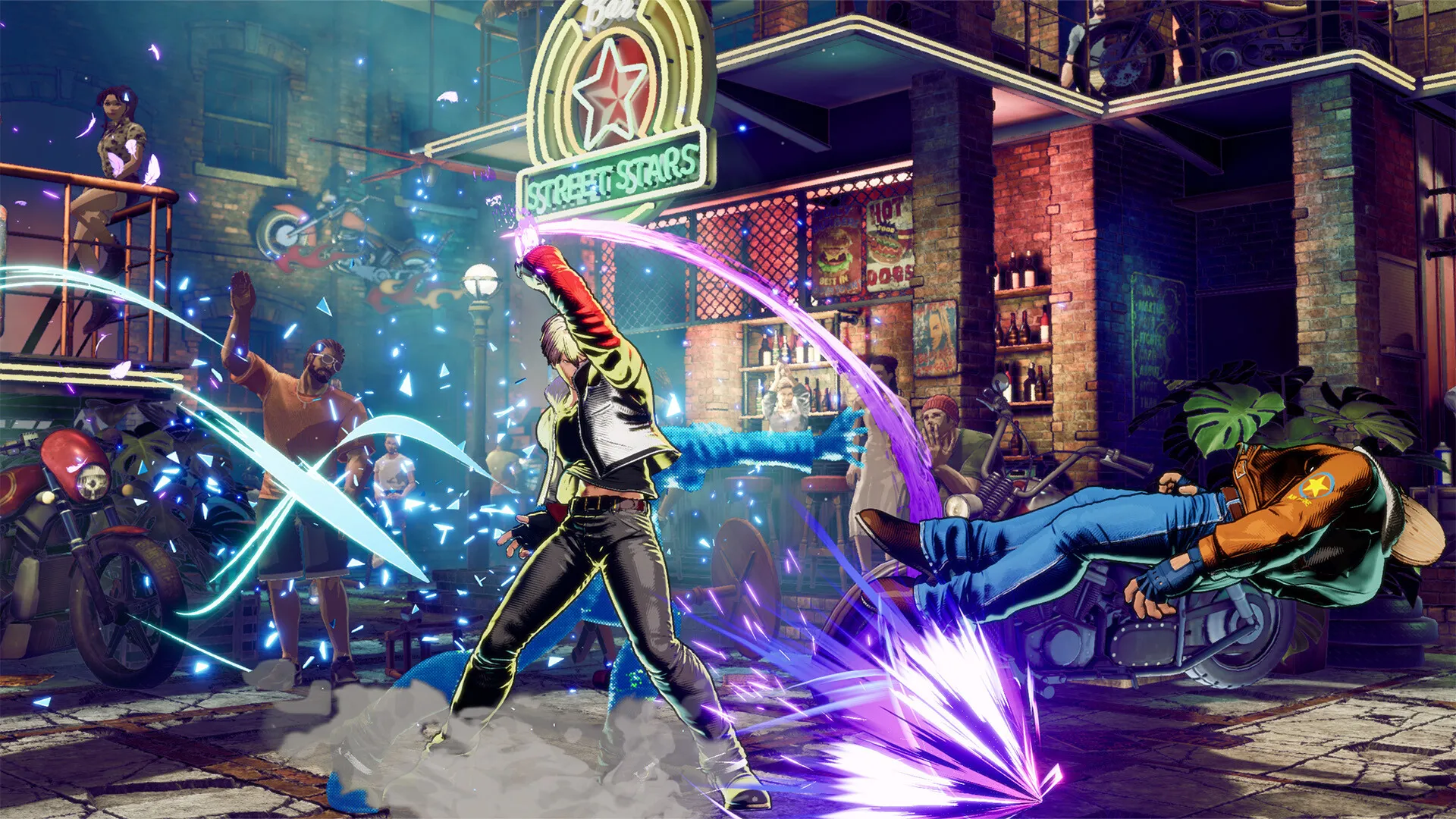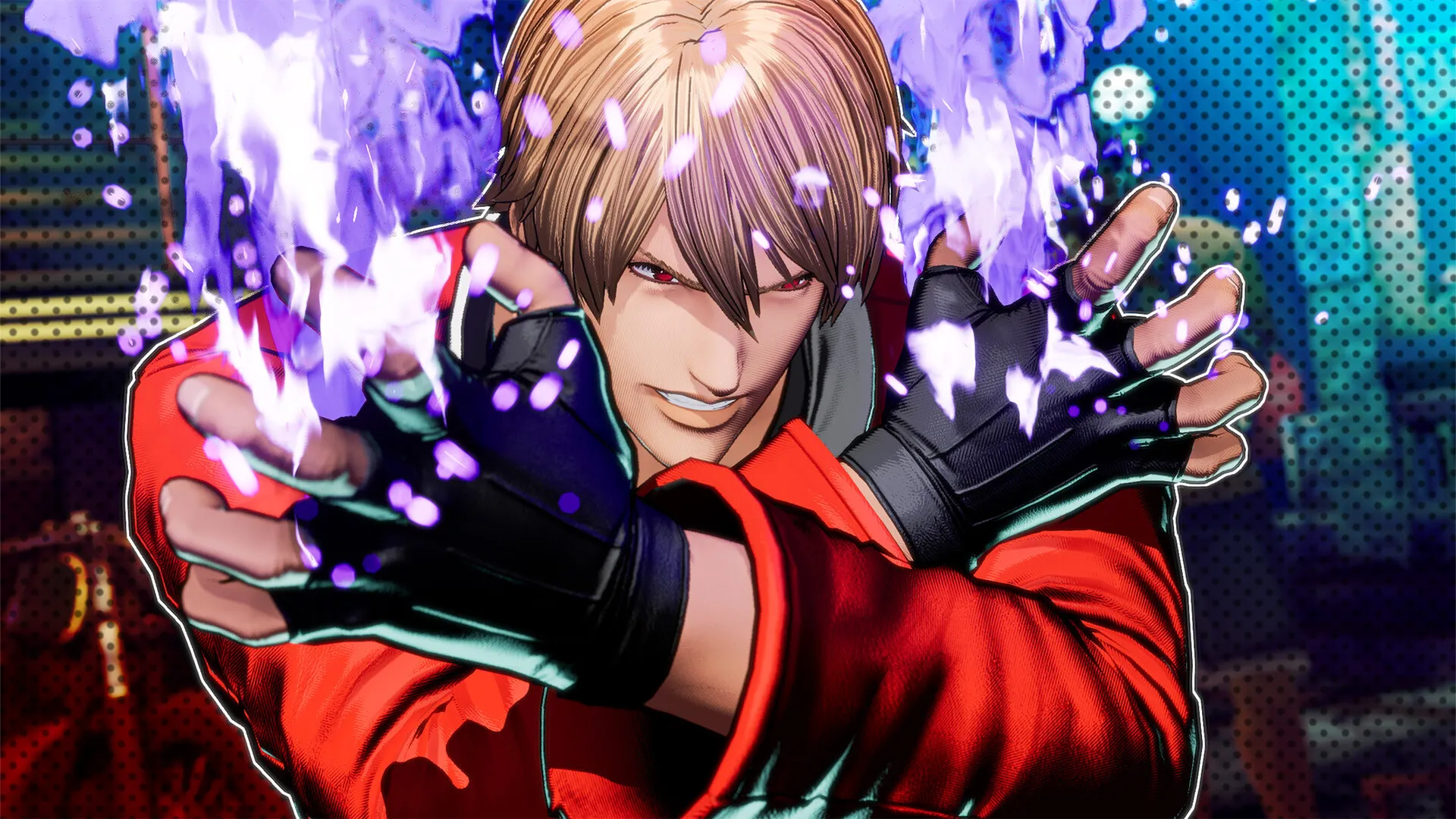Fatal Fury: City of the Wolves arrives 26 years after Garou: Mark of the Wolves, marking the return of SNK’s classic one‑on‑one gameplay. During that hiatus, SNK focused its energy on King of Fighters and Samurai Shodown, leaving direct rival‑versus‑rival fans without their flagship series. City of the Wolves picks up where its predecessor left off, with a four‑button layout—close and far versions of punch and kick—that rewards precise spacing and well‑timed antiairs.
Seventeen fighters fill the roster at launch: veterans from the original cast, four fresh combatants bringing new tactical tools, and two real‑world guests whose gimmicks shake up familiar matchups. Single players can climb the traditional Arcade ladder or explore Episodes of South Town, a map‑driven RPG mode that ties narrative beats to sequential battles and light progression. Online lobbies rely on rollback netcode for smoother matches, though menu navigation can feel rough around the edges.
At its core, City of the Wolves weaves narrative threads into its systems. Meter management, selective potential gear placement, and bespoke approach tools create moments where mechanical choices carry story weight—whether you’re conserving your Rev meter to survive a comeback or positioning SPG to unlock a dramatic reversal. Nostalgia draws you in, but meter‑driven decision making and character‑specific approach options build new layers of depth beneath South Town’s celebrated streets.
Resourceful Encounters
The heart of Fatal Fury’s combat lies in its four‑button, close‑and‑far scheme. Light and heavy punches and kicks each split into two ranges, rewarding precise spacing. Unlike fighters that hand you a universal dash or teleport to bypass neutral—think Street Fighter 6’s Drive dash—City of the Wolves forces you to read each character’s bespoke approach tools.
A fast plus‑on‑block dash belongs only to certain fighters; others rely on projectiles or careful footsie. That tension turns every opening into a small puzzle: do you risk a far‑range poke that can whiff punish, or step in close for a higher‑damage launcher? It echoes tactical RPGs where positioning underpins every engagement.
Beneath the normals sits the Rev Meter, a resource you build by blocking or using Rev techniques—EX specials, Rev Guard, Rev Blows. Once it hits 100 percent, you overheat: Rev options lock out, your guard gauge bleeds down, and one more block shatters your defense. It recalls the drive system in Street Fighter 6, only here you gain meter instead of burning it down, turning each combo decision into a gamble.
Do you extend a juggle with EX specials and edge closer to overheat, or finish with a simpler string and keep your options open? In RPGs like Persona 5, you decide whether to spend all your SP on a mega spell or conserve it for the next boss. Fatal Fury’s Rev flow sits in that same space of dynamic risk versus reward.
Selective Potential Gear adds another layer. Before each fight, you choose the segment of your health bar—start, middle, or end—where SPG activates and grants Rev Blow access. That choice feels like an RPG gear setup: you slot your strongest ability where it best serves your playstyle. A glass‑cannon might pick the start, opening with armored reversals, while a defensive player tucks it near the end for a clutch comeback.
Combo design balances entry‑level and high‑execution routes. You can chain EX specials into supers for reliable damage, or flex your fingers on advanced Brakes—interrupting a special to segue into an unorthodox string—or feints that bait anti‑airs. Indie fighters like Skullgirls offer similar depth via its custom combo paths, but City of the Wolves keeps its system approachable: each advanced extension brings a clear payoff.
Defense meets offense through Just Defend and Perfect Defend, which—when timed—unlock guard cancels into punishes. High and low dodges, forward/back rolls with brief throw invulnerability, and hyper defense all reward timing over mashing.
By stripping out universal dashes, vanish steps, or invulnerable quick recoveries, the game asks you to master each character’s toolkit. That focus on bespoke mechanics gives every matchup its own rhythm, forging a connection between system and narrative: every fighter’s style tells its story through how you move, meter, and strike.
A Cast of Contenders
Fatal Fury: City of the Wolves welcomes back 13 veterans from Garou and earlier chapters, then injects fresh blood with four newcomers. Two original fighters—Preecha and Vox Reaper—arrive alongside Cristiano Ronaldo and Salvatore Ganacci, whose celebrity gimmicks upend expectations.
Preecha blends Muay Thai discipline with lab‑borne flair. Her arsenal of flashy strikes and mid‑screen combinations feels inviting for newcomers while offering nuanced timing loops for veterans. Vox Reaper embodies rushdown energy: lightning‑fast divekicks, a plus‑on‑block dash and relentless corner pressure that reward aggression yet demand split‑second decisions. These designs recall party‑based RPGs where each member’s role must mesh—tank, DPS, support—so squads feel balanced and every selection matters.
By contrast, Ronaldo and Ganacci feel grafted onto the South Town narrative. Ronaldo’s soccer‑ball setups introduce unpredictable zoning, yet the theme clashes with the city’s gritty tone, as if an indie RPG suddenly offered a pop‑culture cameo without narrative weight. Ganacci brings humor through DJ‑driven attacks but trades speed for spectacle, turning some matchups into slow‑burn punchlines. Core roster slots might’ve given room for underrepresented classics, deepening ties to the world rather than leaning on sportswashing buzz.
Balance shows cracks when SPG alignment leaves players without Rev Blow access at critical life‑bar segments. At low‑mid skill tiers, Rev Blows can dominate exchanges when they arrive uncontested, echoing indie fighters like Skullgirls before balance patches smoothed out overpowered combos. Character‑specific approach tools breed uneven matchups—some fighters boast safer get‑in options, while others risk heavy punishment. Future updates and DLC roster additions could redistribute strengths and shore up disparity. The current lineup paints a vivid tapestry of styles, each matchup a test of adaptive play.
South Town’s Solo Showcase
Choosing Arcade Mode feels like stepping into a familiar alleyway brawl. Each character’s run pairs an opening vignette, a rival encounter and a unique ending that weaves snippets of lore into every fight. Dialogue lines nod to old rivalries and hint at individual motivations, giving veterans a taste of nostalgia while guiding newcomers through memorable set pieces. The straightforward ladder structure keeps focus on mastering spacing, normals and Rev‑meter tactics without overwhelming players with extraneous objectives.
Here the game borrows from light RPG design: a city map lets you pick battles to earn XP, unlock skills and boost stats. As you level up, new Rev techniques and guard options become available—each upgrade mirroring narrative progression as your fighter overcomes personal obstacles.
Varied battle conditions, from gauntlets against multiple foes to SPG‑only duels or rare one‑hit‑kill scenarios, force you to adapt playstyles. That tension between story and system recalls indie RPGs like Undertale, where risk‑heavy challenges underscore emotional stakes. Unlockable art galleries and music tracks reward exploration, turning every skirmish into a discovery of South Town’s hidden corners.
Combo trials and mission challenges serve double duty: they teach advanced mechanics—Brakes, feints and perfect‑defend setups—while framing each lesson as a personal milestone. A robust gallery archives character artwork and animated portraits, sketching a richer portrait of each fighter’s backstory.
The jukebox archives decades of Fatal Fury themes, letting players trace the series’ evolution through music. A custom color editor adds a final touch of agency, letting you stamp your style onto iconic fighters. These extras reinforce the bond between mechanical mastery and narrative immersion, granting players both the toolkit and the context to make every match feel consequential.
Connected Skirmishes
Rollback netcode drives City of the Wolves’ online play, delivering generally smooth matches that mirror in‑person timing. In stable connections, each Normal and Rev interaction feels crisp—almost as if you’re sparring in the Arcade. At its worst, eight frames of lag creep in, turning precise spacing into a guessing game. That level of delay recalls early rollback implementations in indie fighters like Skullgirls before netcode refinements smoothed out the rough edges.
Players can dive into ranked and casual modes or host room matches accommodating up to eight participants. A built‑in replay theater records every bout, letting you review clutch reversals or dropped combos. Without a character filter or advanced search, finding a specific bout becomes a test of patience—an odd hiccup given the precision built into the in‑match mechanics.
Menu navigation feels mismatched to the fighting depth within. The lobby browser leans on mouse‑driven lists and plain boxes, evoking a spreadsheet more than a fighting game’s intensity. Yet once a match begins, the HUD shines: clear health bars, meter gauges and SPG markers keep focus sharp. That contrast underscores a design choice to prioritize in‑match fidelity over polished interfaces, reminding players that here, every frame and meter decision carries the weight of their South Town legacy.
A Cinematic Canvas
Graphical fidelity blends 3D models with 2D‑style frames, giving moves a hand‑drawn energy similar to Hollow Knight’s fluidity. Stages pulse with life—animated onlookers, interactive backgrounds and neon‑lit streets that echo South Town’s gritty history. Iconic locales from 1999 return, polished yet faithful to their original spirit.
Audio choices bridge eras: updated remixes of classic themes swirl with fresh compositions, guiding emotional highs and lows. Each strike lands with a hollow thud; Rev Blows chime like armored resolve. Limited voice lines in Episodes of South Town add story punctuation, while Arcade matches let characters trade quips that reinforce their motivations.
The in‑match HUD lays out health, Rev Meter and SPG segments in clear, minimal panels that stay out of your way. Menu screens, however, adopt a stark black‑and‑yellow grid that feels more like an unfinished tool than a curated entryway into this revived universe.
Learning the Ropes
City of the Wolves offers two input schemes. Arcade Style demands classic quarter‑circle and charge motions, giving players full control over combos and timing. Smart Style maps strings to single buttons, lowering the barrier for newcomers. Smart Style shines in casual matches and story play, yet it reaches its limits once you face intermediate combos or online rivals, making it a gateway rather than a destination.
The tutorial suite introduces movement, normals, special moves and Rev Meter basics. It demonstrates Rev Blows and Guard Cancels in isolation, while Brakes, Feints and optimal Rev timing remain without guided practice. Those systems feel under‑emphasized during Episodes of South Town encounters, pushing players to uncover depth through repetition rather than structured drills.
Introducing interactive drill arenas—where you isolate each advanced mechanic against a scripted opponent—would build muscle memory before real matches. Contextual hints that appear during story battles, explaining Rev timing or brake cancels in the moment, could merge learning with narrative flow, tying every technical discovery back to a character’s struggle on the streets of South Town.
The Review
Fatal Fury: City of the Wolves
Fatal Fury: City of the Wolves reclaims SNK’s legacy with razor‑sharp combat, resourceful story modes and striking presentation. Its four‑button scheme and Rev system deliver strategic depth that invites both veterans and newcomers, while Episodes of South Town weaves progression into narrative. Minor frustrations—spotty tutorials, clunky menus and uneven guest slots—leave room for polish. As a fighter, it stands with modern rivals and earns its place in any collection.
PROS
- Deep Rev Meter system that rewards on‑the‑fly resource decisions
- Diverse roster with distinct approach tools and playstyles
- Episodes of South Town blends RPG progression with narrative
- Smooth rollback netcode for most online matches
- 3D visuals infused with 2D animation and a rich soundtrack
CONS
- Menus feel under‑polished and clumsy to navigate
- Tutorials omit practice for advanced techniques
- Guest characters clash tonally with core roster
- SPG placement can create balance hiccups









































